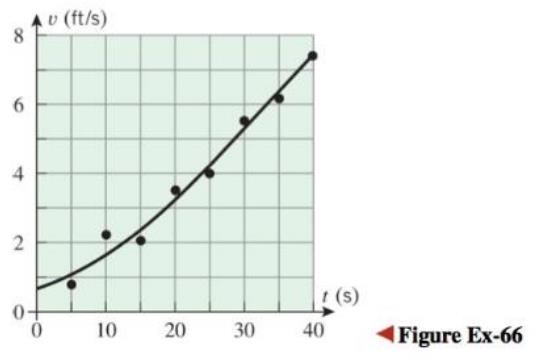
The velocity of a particle moving along an s-axis is measured at
, and the velocity function is modeled by a smooth curve. (The curve and the data points are shown in the accompanying figure.) Use this model in each part.
(a) Does the particle have constant acceleration? Explain your reasoning.
(b) Is there any
(c) Estimate the distance traveled by the particle from time
(d) Estimate the average velocity of the particle over the
time period.
(e) Is the particle ever slowing down during the
(f) Is there sufficient information for you to determine the s-coordinate of the particle at time

Want to see the full answer?
Check out a sample textbook solution
Chapter 5 Solutions
Calculus Early Transcendentals, Binder Ready Version
Additional Math Textbook Solutions
Thinking Mathematically (6th Edition)
Calculus: Early Transcendentals (2nd Edition)
Probability And Statistical Inference (10th Edition)
Introductory Statistics
Elementary Statistics: Picturing the World (7th Edition)
A First Course in Probability (10th Edition)
- The graph of f(x) is given below. Select each true statement about the continuity of f(x) at x = -4. Select all that apply: ☐ f(x) is not continuous at x = -4 because it is not defined at x = −4. ☐ f(x) is not continuous at x = -4 because lim f(x) does not exist. x-4 f(x) is not continuous at x = -4 because lim f(x) = f(−4). ☐ f(x) is continuous at x = -4. x-4 ين من طلب نہ 1 2 3 4 5 6 7arrow_forwardThe graph of f(x) is given below. Select each true statement about the continuity of f(x) at x = -1. -7-6-5 N HT Select all that apply: ☐ f(x) is not continuous at x = -1 because it is not defined at x = -1. ☐ f(x) is not continuous at -1 because lim f(x) does not exist. x-1 ☐ f(x) is not continuous at x = -1 because lim f(x) = f(−1). ☐ f(x) is continuous at x = -1. x-1 5 6 7arrow_forwardUse the shell method to find the volume of the solid generated by revolving the region bounded by the curves and lines about the y-axis. y=x², y=7-6x, x = 0, for x≥0arrow_forward
- The graph of f(x) is given below. Select all of the true statements about the continuity of f(x) at x = −3. -7-6- -5- +1 23456 1 2 3 4 5 67 Select the correct answer below: ○ f(x) is not continuous at x = f(x) is not continuous at x = f(x) is not continuous at x = f(x) is continuous at x = -3 -3 because f(-3) is not defined. -3 because lim f(x) does not exist. 2-3 -3 because lim f(x) = f(−3). 2-3arrow_forwardCould you explain how this was solved, I don’t understand the explanation before the use of the shift property As well as the simplification afterwardsarrow_forwardQuestion The function f(x) is shown in the graph below. Which of the following statements are true? Select all that apply. f(x) 12 10 -16 -14 -12 -10 -8 + -4 " 10 12 14 16 a Select all that apply: ☐ Condition 1 is satisfied. ☐ Condition 2 is satisfied. ☐ Condition 3 is satisfied. ☐ f(x) is continuous.arrow_forward
- Find the equation of the line / in the figure below. Give exact values using the form y = mx + b. m = b = y WebAssign Plot f(x) = 10* log 9 Xarrow_forwardA particle travels along a straight line path given by s=9.5t3-2.2t2-4.5t+9.9 (in meters). What time does it change direction? Report the higher of the answers to the nearest 2 decimal places in seconds.arrow_forwardUse the method of disks to find the volume of the solid that is obtained when the region under the curve y = over the interval [4,17] is rotated about the x-axis.arrow_forward
- 1. Find the area of the region enclosed between the curves y = x and y = x. Sketch the region.arrow_forwardfor the given rectangular coordinates, find two sets of polar coordinates for which 0≤θ<2π, one with r>0 and the other with r<0. (-2sqrt(3),9)arrow_forwardI circled the correct answer, could you show me how to do it using divergence and polar coordinatesarrow_forward
- Algebra & Trigonometry with Analytic GeometryAlgebraISBN:9781133382119Author:SwokowskiPublisher:Cengage
 Trigonometry (MindTap Course List)TrigonometryISBN:9781305652224Author:Charles P. McKeague, Mark D. TurnerPublisher:Cengage Learning
Trigonometry (MindTap Course List)TrigonometryISBN:9781305652224Author:Charles P. McKeague, Mark D. TurnerPublisher:Cengage Learning
 Functions and Change: A Modeling Approach to Coll...AlgebraISBN:9781337111348Author:Bruce Crauder, Benny Evans, Alan NoellPublisher:Cengage Learning
Functions and Change: A Modeling Approach to Coll...AlgebraISBN:9781337111348Author:Bruce Crauder, Benny Evans, Alan NoellPublisher:Cengage Learning



